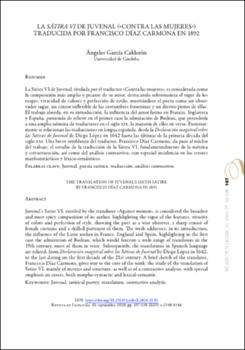La Sátira VI de Juvenal («Contra las mujeres») traducida por Francisco Díaz Carmona en 1892
Author
García Calderón, AngelesDate
2020Abstract
La Sátira VI de Juvenal, titulada por el traductor «Contra las mujeres», es considerada como
la composición más amplia y picante de su autor, destacando sobremanera el vigor de los
rasgos, vivacidad de colores y perfección de estilo, mostrándose el poeta como un observador sagaz, un censor inflexible de las costumbres femeninas y un diestro pintor de ellas.
El trabajo aborda, en su introducción, la influencia del autor latino en Francia, Inglaterra
y España, poniendo de relieve en el primer caso la admiración de Boileau, que precedería
a una amplia nómina de traductores en el siglo xix, la mayoría de ellos en verso. Posteriormente se relacionan las traducciones en lengua española, desde la Declaración magistral sobre
las Sátiras de Juvenal de Diego López en 1642 hasta las últimas de la primera década del
siglo xxi. Una breve semblanza del traductor, Francisco Díaz Carmona, da paso al núcleo
del trabajo: el estudio de la traducción de la Sátira VI, fundamentalmente de la métrica
y estructuración, así como del análisis contrastivo, con especial incidencia en los errores
morfosintácticos y léxico-semánticos. Juvenal’s Satire VI, entitled by the translator «Against women», is considered the broadest
and most spicy composition of its author, highlighting the vigor of the features, vivacity
of colors and perfection of style, showing the poet as a wise observer, a sharp censor of
female customs and a skilled portrayer of them. The work addresses, in its introduction,
the influence of the Latin author in France, England and Spain, highlighting in the first
case the admiration of Boileau, which would forerun a wide range of translators in the
19th century, most of them in verse. Subsequently, the translations in Spanish language
are related, from Declaración magistral sobre las Sátiras de Juvenal by Diego López in 1642,
to the last dating on the first decade of the 21st century. A brief sketch of the translator,
Francisco Díaz Carmona, gives way to the core of the work: the study of the translation of
Satire VI, mainly of metrics and structure, as well as of a contrastive analysis, with special
emphasis on errors, both morpho-syntactic and lexical-semantic.





